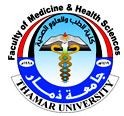طلبات النشر
متطلبات تحضير طلب النشر
كجزء من عملية تقديم طلب النشر، على المؤلفين التأكد من كون طلباتهم مستوفية لجميع الفقرات الآتية، وعليه، فقد تُرد الطلبات التي لا تلبي تلك الضوابط.- هذا المؤلَّف لم يسبق له النشر، ولم يُعرض على مجلة علمية أخرى للنظر فيه (أو هناك توضيح بشأن هذا الأمر مقدم إلى هيئة التحرير في خانة التعليقات).
- ملف التقديم هو بإحدى الصيغ الآتية: OpenOffice, Microsoft Word, RTF, WordPerfect.
- حيثما تطلب الأمر، أضيفت روابط للمراجع المستعملة في المؤلَّف (الروابط هي وصلات إلى العناوين على الشبكة العنكبوتية).
- فقرات النص ذات تباعد مفرد للأسطر، بحجم خط (12) نقطة، تم فيه استعمال الخط المائل بدلاً عن الخط التحتاني (باستثناء عناوين الروابط)، وجميع الرسوم والأشكال والجداول متوضعة ضمن النص المتعلق بها عوضاً عن تجميعها في نهاية الملف.
- إن نص المؤلَّف مقيد بالمتطلبات النمطية والأسلوبية الواردة في دليل المؤلِّف، الموجود في النص التعريفي بالمجلة ضمن هذا الموقع.
Default
<strong>Annals of Medicine & Health (AMH) (Print ISSN: 2710-4214; Online ISSN: 2710-</strong><strong>4222)</strong>, is a peer reviewed open access medical journal that established and published by a governmental medical faculty titled Thamar University Faculty of Medicine & Health Sciences (TUFMHS). All degree and certificate programs at the TUFMHS are approved and officially registered with the Ministry of Higher Education in Yemen. TUFMHS is accredited by WHO and listed in the World Directory of Medical Schools (FAIMER SCHOOL ID: F0002394) <a href="https://search.wdoms.org/home/SchoolDetail/F0002394" target="_blank" rel="noopener noreferrer" data-mce-href="https://search.wdoms.org/home/SchoolDetail/F0002394">https://search.wdoms.org/home/SchoolDetail/F0002394</a>.AMH is aimed to publish original articles, short communications, case reports/case series, and methods and devices on basic, clinical, and epidemiological medical research issues covering topics from medicine, laboratory medicine, basic and applied medical sciences, dentistry, pharmacy, and nursing. Other features within the journal include reviews (systematic and narrative), editorials, letters to the editor, and updates which detail conferences, symposia, and workshops located primarily in the Republic of Yemen.<strong>The topics related to this journal include but are not limited to:</strong><li>Internal Medicine and sub-specialties</li><li>General Surgery and sup-specialties</li><li>Obstetrics and Gynecology</li><li>Pediatrics</li><li>Pathology and Laboratory Medicine</li><li>Community Medicine and Public Health</li><li>Pharmacology and Pharmaceutical Sciences</li><li>Basic Medical Sciences</li>
بيان الخصوصية
أسماء الأشخاص وعناوين البريد الالكتروني المحفوظة في موقع المجلة هذا ستتم الاستفادة منها حصرياً للأغراض المنصوص عليها من قبل المجلة، ولن تكون متاحة لأي أغراض أخرى أو لأي طرف ثالث

